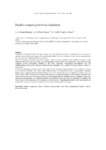Mostrar o rexistro simple do ítem
Parallel computing for brain simulation
| dc.contributor.author | Pastur-Romay, L.A. | |
| dc.contributor.author | Porto-Pazos, Ana B. | |
| dc.contributor.author | Cedrón, Francisco | |
| dc.contributor.author | Pazos, A. | |
| dc.date.accessioned | 2017-06-09T08:21:05Z | |
| dc.date.issued | 2017-05-01 | |
| dc.identifier.citation | Pastur-Romay LA, Porto-Pazos AB, Cedrón F, Pazos A. Parallel computing for brain simulation. Curr Top Med Chem. 2017;17(14):1646-1668 | es_ES |
| dc.identifier.issn | 1568-0266 | |
| dc.identifier.issn | 1873-4294 | |
| dc.identifier.uri | http://hdl.handle.net/2183/19160 | |
| dc.description.abstract | [Abstract] Background: The human brain is the most complex system in the known universe, it is therefore one of the greatest mysteries. It provides human beings with extraordinary abilities. However, until now it has not been understood yet how and why most of these abilities are produced. Aims: For decades, researchers have been trying to make computers reproduce these abilities, focusing on both understanding the nervous system and, on processing data in a more efficient way than before. Their aim is to make computers process information similarly to the brain. Important technological developments and vast multidisciplinary projects have allowed creating the first simulation with a number of neurons similar to that of a human brain. Conclusion: This paper presents an up-to-date review about the main research projects that are trying to simulate and/or emulate the human brain. They employ different types of computational models using parallel computing: digital models, analog models and hybrid models. This review includes the current applications of these works, as well as future trends. It is focused on various works that look for advanced progress in Neuroscience and still others which seek new discoveries in Computer Science (neuromorphic hardware, machine learning techniques). Their most outstanding characteristics are summarized and the latest advances and future plans are presented. In addition, this review points out the importance of considering not only neurons: Computational models of the brain should also include glial cells, given the proven importance of astrocytes in information processing. | es_ES |
| dc.description.sponsorship | Galicia. Consellería de Cultura, Educación e Ordenación Universitaria; GRC2014/049 | es_ES |
| dc.description.sponsorship | Galicia. Consellería de Cultura, Educación e Ordenación Universitaria; R2014/039 | es_ES |
| dc.description.sponsorship | Instituto de Salud Carlos III; PI13/00280 | es_ES |
| dc.language.iso | eng | es_ES |
| dc.publisher | Bentham Science | es_ES |
| dc.relation.uri | http://dx.doi.org/10.2174/1568026617666161104105725 | es_ES |
| dc.rights | The published manuscript is avaliable at EurekaSelect | es_ES |
| dc.subject | Parallel computing | es_ES |
| dc.subject | Brain emulation | es_ES |
| dc.subject | Neuromorphic chips | es_ES |
| dc.subject | Brain computational models | es_ES |
| dc.subject | Neuronastrocyte networks | es_ES |
| dc.title | Parallel computing for brain simulation | es_ES |
| dc.type | info:eu-repo/semantics/article | es_ES |
| dc.rights.access | info:eu-repo/semantics/embargoedAccess | es_ES |
| dc.date.embargoEndDate | 2018-05-01 | es_ES |
| dc.date.embargoLift | 2018-05-01 | |
| UDC.journalTitle | Current Topics in Medicinal Chemistry | es_ES |
| UDC.volume | 17 | es_ES |
| UDC.issue | 14 | es_ES |
| UDC.startPage | 1646 | es_ES |
| UDC.endPage | 1668 | es_ES |
Ficheiros no ítem
Este ítem aparece na(s) seguinte(s) colección(s)
-
GI-RNASA - Artigos [177]
-
INIBIC-RNASA-IMEDIR - Artigos [46]






